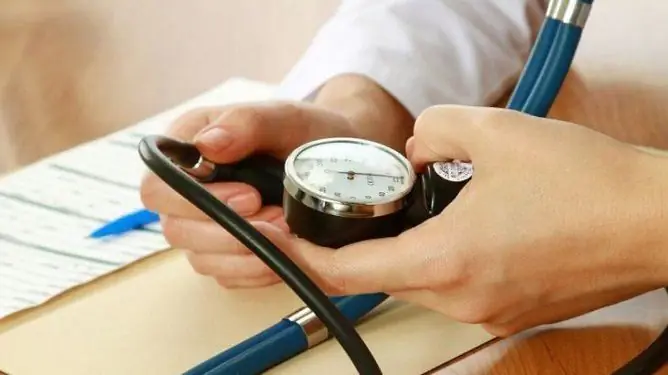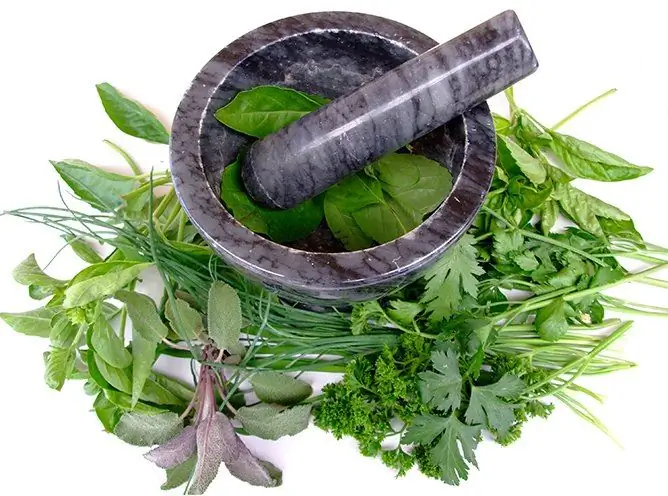- Author Rachel Wainwright [email protected].
- Public 2023-12-15 07:39.
- Last modified 2025-11-02 20:14.
What is blood pressure?
The content of the article:
- Physiology of pressure
- Blood pressure rates by age
-
Increasing and decreasing pressure
- Hypertension
- Hypotension
- Video
Blood pressure is the force with which blood presses against the walls of blood vessels. This is one of the most important parameters of homeostasis, which has a complex effect on all organs and systems, indicating the state of the body as a whole. This indicator depends on many factors, including the frequency and strength of heart contractions, the state of blood vessels, their elasticity, the presence of damage, the volume of circulating blood, etc. Since the pressure is easy to measure, this value serves as a convenient diagnostic tool by which you can predict the presence and the development of some diseases, primarily the cardiovascular system. The stability of blood pressure (BP) indicates the functional viability of the body, and its disturbances - about diseases.

It is necessary to constantly monitor your blood pressure, it is especially important to do this for the elderly
Physiology of pressure
What is blood pressure? This is the pressure of blood on the vascular wall or the wall of the organic reservoir, in which it is located, respectively, it is intracardiac, arterial, venous, capillary. Indicators of all these types of pressure vary significantly, primarily due to the properties of the vessels themselves. The most persistent, high and easy to measure is blood pressure, the definition of which is most often used in the clinic and in everyday life.
The heart contracts, ejecting a pulse wave of blood at tremendous speed through an elastic tube - an artery, which, thanks to its elastic fibers, compensates for the shock, absorbs the energy transmitted by the heart muscle, and allows blood to move further and further along the bloodstream. The pressure decreases in the direction from the heart, reaching minimum values in large-caliber veins with a large cross-sectional diameter, in which the content of elastic elements is minimal.
Organs that mainly influence and maintain pressure:
- Heart - the stronger the release of blood from the heart, the more often the heart muscle contracts, the higher the blood pressure. The upper, systolic pressure, that is, recorded at the time of contraction, largely depends on the strength of the heart's contractions. Changes in systolic pressure allow you to indirectly judge the state of the heart.
- Vessels - the pressure indicator directly depends on the state of the vessels, because if a person has atherosclerosis, vessel obstruction, damage or fragility of the vascular wall, all this will be reflected in the blood pressure indicator. Prolonged hypertension causes degeneration of the elastic elements of the wall, which has a bad effect on the compensatory abilities of the vessels.
- Kidneys - these paired filter organs affect the volume of circulating blood both directly (the more blood in the stream, the higher the pressure) and with the help of biologically active substances. Renin is produced in the kidneys, which, through a chain of reactions, is converted into angiotensin II, a powerful vasoconstrictor. The kidneys affect peripheral vascular resistance. Deviations in diastolic, or lower pressure, often indicate the presence of renal disease.
- Endocrine glands - the adrenal glands secrete aldosterone, which affects the filtration and reabsorption of sodium ions, which retains water. The posterior lobe of the pituitary gland stores vasopressin, a powerful hormone that decreases urine production.
Blood pressure rates by age
To monitor the state of the cardiovascular system, it is necessary to regularly measure blood pressure, especially in the presence of hypertension or a tendency to it, as well as a number of other pathologies. To do this, you will need a classic tonometer and a stethoscope, or a modern automatic and semi-automatic device for self-measurement of blood pressure - everyone can easily handle them.
Measurements are taken with two hands. The cuff of a classic blood pressure monitor is placed above the elbow, approximately at the same level with the heart, and for an electronic blood pressure monitor, on the wrist. When measuring manually, the Korotkoff method is used - pressurize the cuff until special sound vibrations are heard - tones. After that, they continue to pump until the tones stop, after which, slowly lowering the air, the upper and lower blood pressure is recorded according to the first and last tone, respectively. All you need to measure blood pressure with an automatic tonometer is to press a button. The device will work by squeezing the arm with the cuff, and then display the result on the display.
Pressure is measured in millimeters of mercury, abbreviated as mm Hg. Art. The generally accepted norm is 120/80 mm Hg. Art. for a mature person 20-40 years old. Normal blood pressure varies for different age categories, and on average is:
- in children under one year old - 90/60 mm Hg. Art.;
- from one to 5 years - 95/65 mm Hg. Art.;
- 6-13 years old - 105/70 mm Hg. Art.;
- 17-40 years old - 120/80 mm Hg. Art.;
- 40-50 years - 130/90 mm Hg. Art.
The tables of age norms have been developed, by which it is possible to determine the optimal indicator taking into account gender. However, it should be borne in mind that the individual rate may differ, as it depends on a number of parameters.
When a person reaches 60 years of age, due to the natural degradation of elastic fibers in the vessel wall, his pressure, as a rule, becomes higher than at a young age.

Blood pressure rates change with age
There is a concept of high and low blood pressure. Hypotension (persistent lowering of blood pressure) is spoken of at 100/60 mm Hg. Art., decreased normal - 110/70, normal - 120/80, increased normal - up to 139/89, everything that exceeds this figure is called arterial hypertension.
Increasing and decreasing pressure
Pressure deviations from the norm are of two types - hypertension (pathological increase) and hypotension (pathological decrease in blood pressure).
Hypertension
Arterial hypertension can be caused by many reasons - atherosclerosis, diabetes mellitus, bad habits, in particular, smoking, taking oral contraceptives, imbalance of proteins, fats and carbohydrates in the diet, excessive consumption of trans fats, a sedentary lifestyle, salt abuse contributes to its appearance in food products, tonic drinks. It can also occur as a consequence of primary heart disease, kidney disease or endocrine glands, but this form is much less common.
The diagnosis of "hypertension" is not established by the patient independently, it is made by the doctor according to the results of the examination, which includes daily monitoring of blood pressure, biochemical blood test (the presence of certain markers is detected), examination of the fundus, ECG, etc.
What to do if hypertension is detected? First of all, a lifestyle correction is necessary - giving up bad habits, normalizing the diet, establishing a sleep and wakefulness regimen, moderate but regular physical activity, and supportive pharmacotherapy.
Drugs to reduce blood pressure are taken only as directed by a doctor, strictly following the recommendations. Treatment of hypertension is long-term and requires patience and self-discipline from the patient.
Hypotension
Low blood pressure (hypotension) is no less serious ailment, it indicates insufficient blood supply to the main organs, in which, because of this, functional and then organic disorders develop first.
Hypotension can be caused by bleeding, extensive burns, neuro-emotional stress, insufficient fluid intake or increased excretion from the body. Hypotension develops with heart or vascular failure, when peripheral vessels lose their tone (for example, in shock conditions) due to an allergic reaction. The most dangerous complication of hypotension is collapse, the risk of which appears when the pressure drops to 80/60 mm Hg. Art. This condition is fraught with cerebral hypoxia.

Natural black coffee helps to cope with unpleasant symptoms of hypotension
Treatment for hypotension is mostly symptomatic. Chronically low blood pressure is successfully corrected by normalizing the diet and drinking regime, increasing physical activity. A tonic massage, a contrast shower, daily morning exercises, moderate consumption of tonic drinks (strong tea, black coffee) have a good therapeutic effect.
Video
We offer for viewing a video on the topic of the article.

Nikita Gaidukov About the author
Education: 4th year student of the Faculty of Medicine No. 1, specializing in General Medicine, Vinnitsa National Medical University. N. I. Pirogov.
Work experience: Nurse of the cardiology department of the Tyachiv Regional Hospital No. 1, geneticist / molecular biologist in the Polymerase Chain Reaction Laboratory at VNMU named after N. I. Pirogov.
Found a mistake in the text? Select it and press Ctrl + Enter.






